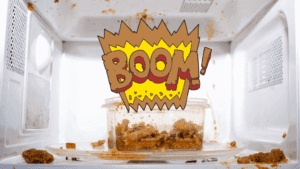
Take your tastebuds on a Hawaiian Vacation
Summer just got here, and this heat already has us dreaming of a sweet island getaway. That’s why this month we turned to the beautiful
Cart
No products in the cart.
Our Website is under maintenance if you run into any issues, please call us (832)-942-4012
In the 1940s, Percy Spencer at Raytheon was testing a magnetron — a device that generates microwaves — when he realized a candy bar in his pocket had melted. This caused him to wonder if the energy from radio waves could be used to cook food. He placed popcorn kernels near the tube; within minutes, he was snacking on the world’s first microwave popcorn. This accidental discovery would lead him to develop what we now know as the modern-day microwave oven. Over the years, this kitchen appliance has become almost statutory in every domestic and commercial kitchen. Yet questions surrounding the safety of microwave ovens remain. Is the radiation used by these ovens safe for humans? Does radiation destroy nutrients in our microwave meals? And is microwave packaging safe?
Microwave ovens produce electromagnetic radiation similar to light. But this is not the type of radiation associated with atomic bombs and nuclear disasters. Microwave ovens produce non-ionizing radiation, which is similar to the radiation from a cell phone although much stronger. Microwave ovens have metal shields and metal screens over the window that prevent the radiation from leaving the oven, so there shouldn’t be any risk of harm. However, this depends on it being in good condition. Since radiation decreases rapidly with distance, it is a good idea to keep your head at last 1 foot away from the oven, in case of undetected flaws.

Burn injuries can result from handling hot items heated in a microwave oven, in the same way as items heated using conventional ovens or cooking surfaces. However, extra care should be taken when heating food in a microwave oven since super-heating can occur when there is no avenue for steam to escape through bubbling action. A single bubble in the liquid or the introduction of a foreign element such as a spoon may trigger a sudden boiling. Another peculiarity of microwave meals relates to the thermal response of specific foods. Certain items with non-porous surfaces (e.g. hotdogs) or a composition of materials that heat at different rates (e.g. yolk and egg whites) heat unevenly and may explode. This can happen if eggs or chestnuts are cooked in their shells.

Food safety is an important health issue. In a microwave oven, the rate of heating depends on the power rating of the oven and on the water content, density and amount of food. Microwave energy does not penetrate well in thicker pieces of food, and may produce uneven cooking. This can lead to a health risk if parts of the food do not get hot enough to kill potentially dangerous micro-organisms. Because of the potential for uneven distribution of cooking, microwave meals should rest for several minutes after cooking is over to allow the heat to distribute throughout the food. Preparing food in a microwave oven is as safe as preparing food in a conventional oven.

All cooking methods reduce nutrient value, but microwaving generally preserves nutrients better than other methods. This is because the main contributing factors are temperature, cooking time, and method. Harvard Health states that food that is cooked for the shortest period of time, and uses as little liquid as possible, will best retain nutrients. A microwave can accomplish this, as it is a faster method of cooking.During boiling, water-soluble nutrients may leak out of the food so, the more watery the food, the greater the risk of nutrient loss. As far as microwaves go, cooking times are generally short and the temperature low. Plus, the food does not usually reach boiling point. Consequently, microwave meals generally retain more nutrients than methods like frying and boiling. In conclusion, microwaves tend to preserve nutrients very well.
Many plastics contain hormone-disrupting compounds like Bisphenol-A (BPA), which can contaminate your food when heated. BPA has been linked to conditions like cancer, thyroid disorders and obesity. Never microwave a plastic container unless it specifically states on the label that it is safe to use. This precaution is not specific to microwaves. Heating your food inside a plastic container is a bad idea — no matter which cooking method you use, unless the packaging states otherwise. Healthy Gourmet’s microwave meals’ sleeves, labels, and trays are not only BPA-free but recyclable as well.
Microwaves are a safe, effective, and highly convenient cooking method. According to the WHO (World Health Organization)
“To dispel some misconceptions, it is important to realize that food cooked in a microwave oven does not become “radioactive”. Nor does any microwave energy remain in the cavity or the food when the microwave oven is off. In this respect, microwaves act just like light; when the light bulb is off, no light remains.”
There is no evidence that microwave meals are harmful and some evidence that they are better than other cooking methods at preserving nutrients. However, you should take care not to overcook or underheat your food, stand too close to the microwave, or heat anything in a plastic container unless the label states that it is safe for use. Happy microwaving!
https://www.healthline.com/nutrition/microwave-ovens-and-health#bottom-line.
https://www.healthline.com/health/under-review-microwaves.
https://www.bbc.com/future/article/20200714-is-it-safe-to-microwave-food.
https://www.health.harvard.edu/staying-healthy/microwave-cooking-and-nutrition.
https://www.webmd.com/food-recipes/features/do-microwaves-zap-nutrition#1.
https://www.fsis.usda.gov/shared/PDF/Microwave_Ovens_and_Food_Safety.pdf.
https://www.sciencefriday.com/articles/demystifying-the-microwave/.
https://www.massmoments.org/moment-details/percy-spencer-inventor-of-microwave-oven-born.html.
https://www.who.int/peh-emf/publications/facts/info_microwaves/en/.

Summer just got here, and this heat already has us dreaming of a sweet island getaway. That’s why this month we turned to the beautiful

Check out how EatFlavorly utilizes Mexican meats and so many more in our scratch-made meals over at Our Menu! With Cinco de Mayo

National Earth day is approaching on Thursday April 22nd. Today, not only is Earth Day a day meant to increase awareness of environmental problems, but
The convenience of home meal delivery is undeniable. Getting food delivered to your door that does not require cooking or cleaning is a huge time-saver.